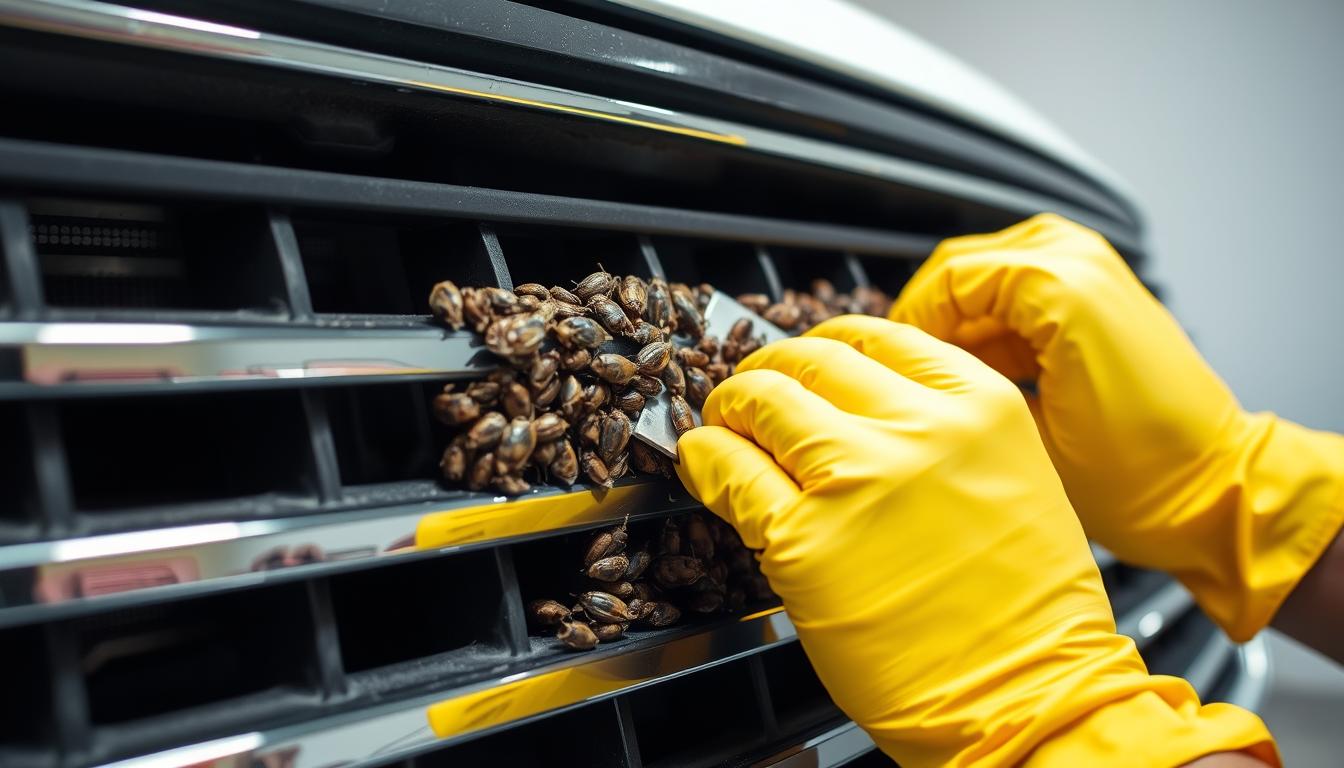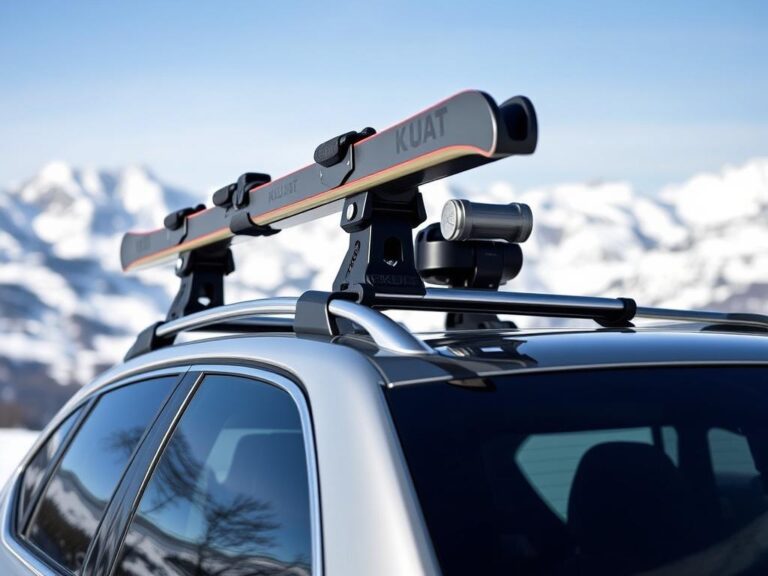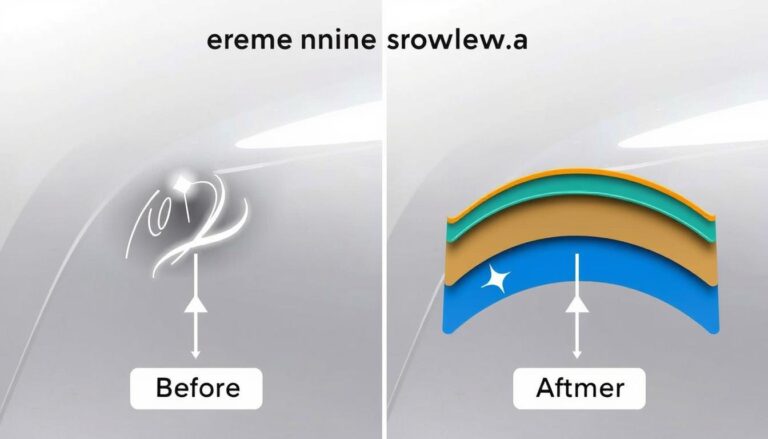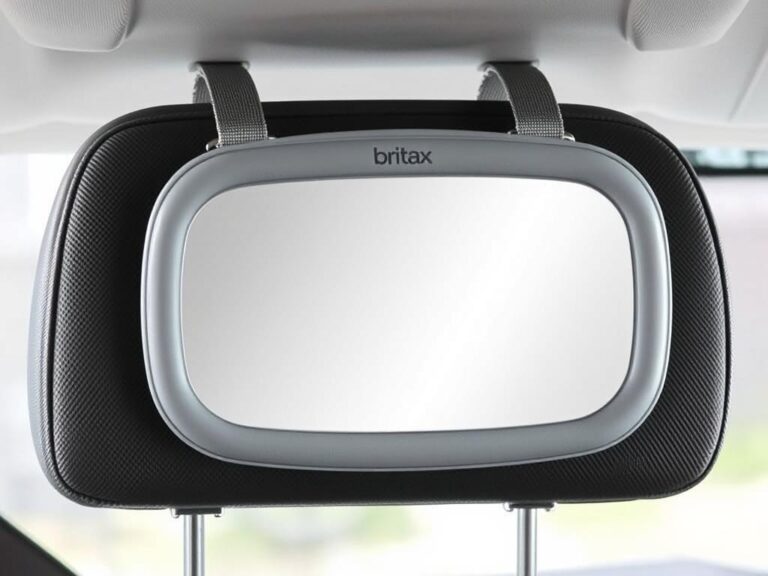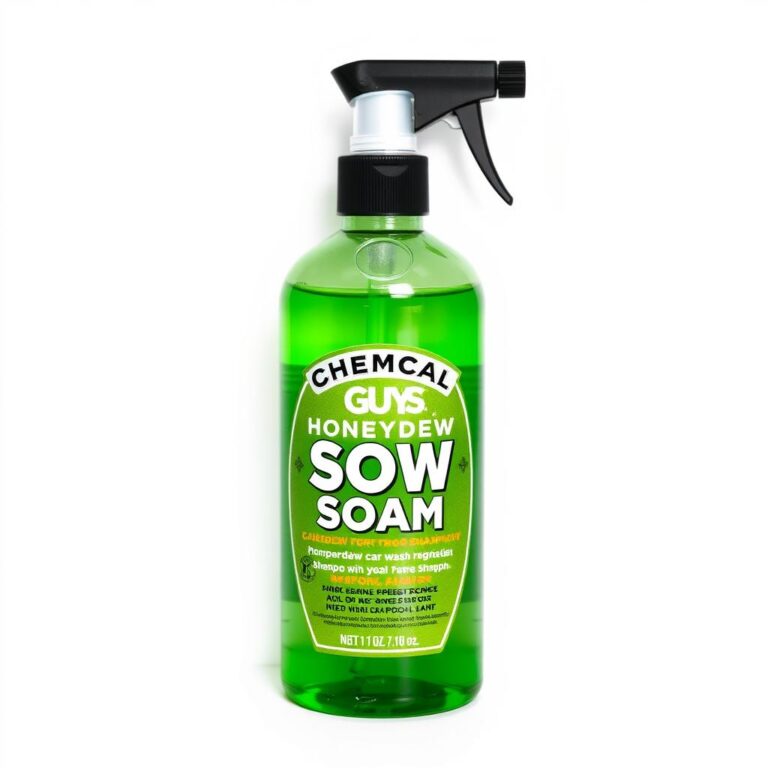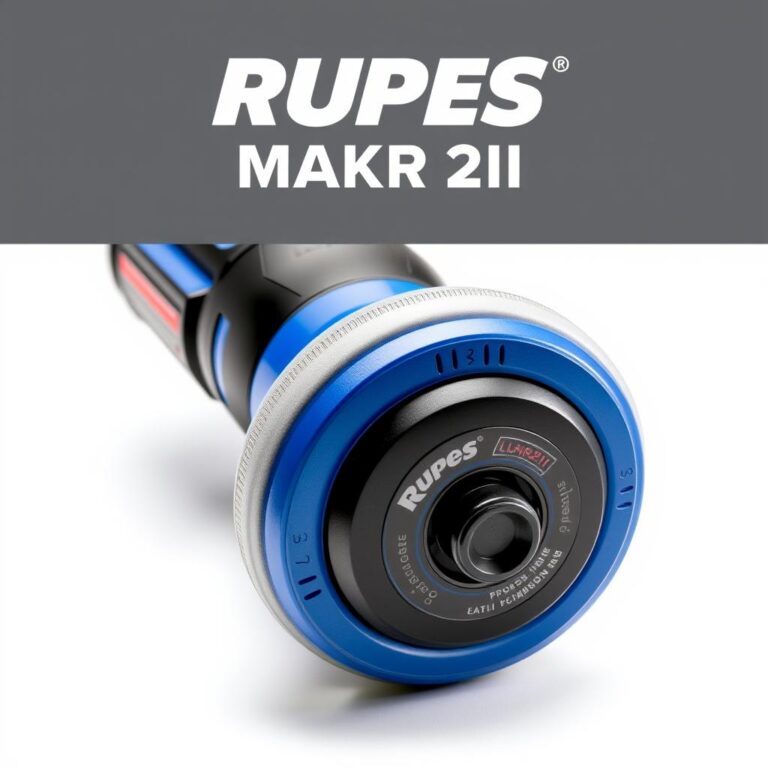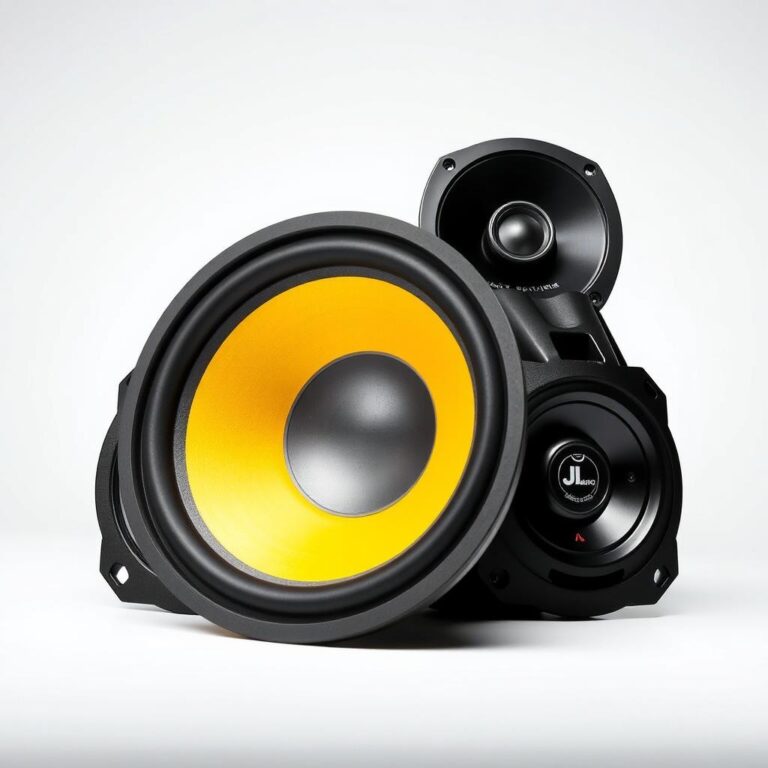Effective Bug Removal from Cars – Best Tips & Tricks
For a scratch-free front end, begin by using gentle methods. Let products sit for 3 to 7 minutes and choose a microfiber towel with a GSM between 350 and 500. The key steps are simple: soften bug residue, gently lift it off, and then protect your car’s finish. This method safely removes bugs while protecting your car’s paint.
Bugs can leave acidic spots (pH around 3 to 5) that damage your car’s clear coat. By soaking them first, you cut down on rubbing and pressure. Less than 1 lb pressure is best to prevent tiny scratches. This guide offers advice and product suggestions for quickly and safely getting rid of bug marks.
We tested different products, looking at their chemistry and how well they work. We compared pH-neutral soaps to slightly alkaline cleansers. We tried sprays, gels, and foams from popular brands. Our tests looked at how long products stay on the car, how easy they rinse off, and feedback from real users on different surfaces.
Here’s what you need to do for cleaning off bugs: Clean in the shade when the car’s surface is cool. Pre-soak the bug spots for 3 to 7 minutes. Use a soft microfiber cloth to pick up the bugs without scrubbing. Rinse your cloth often to remove bugs more effectively. These steps help avoid scratches.
Choosing the right tools and water can make a big difference. A foam pre-wash helps bug cleaner stick better, and using softened water can stop spots from forming. For glass, dense foam sponges work well, but use microfiber on paint to prevent dullness. Finish up with a sealant to make future cleaning easier.
No matter the season or where you are, always soften, lift, and protect. We’ll show you how to handle common issues, like lovebugs in Florida or mayflies in the Midwest. We’ll also cover dealing with bugs on hot bumpers from highway driving. Follow our steps for a bug-free car without losing any shine.
Why Bug Splatter Removal Matters for Your Car’s Paint and Resale Value
Want to keep your car looking shiny and help its trade-in value? Start with removing bug splatters early. The protective coating on your car is very thin, so it doesn’t take much for chemicals to wear it down. Keeping bugs off your car helps keep it smooth and means less polishing later on.
Key takeaway: Quickly cleaning off bugs from your car helps protect its finish and value for when you sell it.
How acidic insect residue affects clear coat longevity
Bug guts are acidic, testing between pH 3–5 because of amino acids and enzymes. When it gets hot, these acids can soften the car’s resin, leading to more damage. The total thickness of a car’s paint job is only about 1.5–2.5 mils, so repeated attacks and tough cleaning can wear it down.
It’s best to remove bug residue gently to avoid needing more work done later. Cleaning off bugs before they are baked on by the sun helps save your car’s clear coat for the future.
Time-to-clean window: preventing etching and staining
Heat makes proteins from bugs stick to your car faster. At temperatures of 90–105°F, they could stick in just hours. Cleaning your car within 24 hours reduces damage; during hot summer days, try to clean it within 6–8 hours. This is especially true for bumpers, mirrors, and hoods where bugs hit the most.
On the other hand, glass doesn’t get damaged as easily, but bug fluids can still leave stains. Chrome and aluminum can get spots too. Cleaning bugs off quickly is key to keeping your car in top condition and avoiding extra work later.
Seasonal and regional bug risks across the United States
The risk of bug splatters varies by location and time of year. In Florida and the Gulf states, lovebug swarms are a big problem in late spring and late summer. Near the Mississippi River and Great Lakes, mayfly numbers go up. And in the Plains, you might run into lots of grasshoppers at sunset.
Driving at night in the Southeast during warm months means more bugs on your car. After driving these routes, plan to clean off the bugs each time. This keeps your car shiny and helps its resale value.
| Region/Season | Primary Insect | Risk Driver | Paint Impact | Recommended Clean Window |
|---|---|---|---|---|
| Florida & Gulf (Apr–May, Aug–Sep) | Lovebugs | High swarm density; humid heat | Fast etching on warm panels | Within 6–8 hours |
| Mississippi River & Great Lakes (Late Spring–Summer) | Mayflies | Bridge lighting; mass hatches | Protein film; glass spotting | Same day, ideally under 12 hours |
| Great Plains (Summer) | Grasshoppers | Dry heat; rural highways | Heavy splatter; baked-on residue | Within 8–12 hours |
| Southeast Nights (Warm Months) | Mixed species | Night drives; high airflow | Frequent accumulation on nose | At next stop or within 12 hours |
For all situations, having a quick, easy, and regular cleaning plan for your car is better than rare intense scrubs. This cleaning routine helps keep your car clear and shiny and reduces costs when selling.
Pre-Wash Prep: Safe Setup for Insect Residue Removal
Before washing your car, setting up your work area is key. These tips focus on keeping the car’s surface cool under 85°F, finding stable shade, and making sure water covers the car evenly. This preparation step makes removing bugs from your car’s paint safer and quicker, cutting down the chance of damage while cleaning.
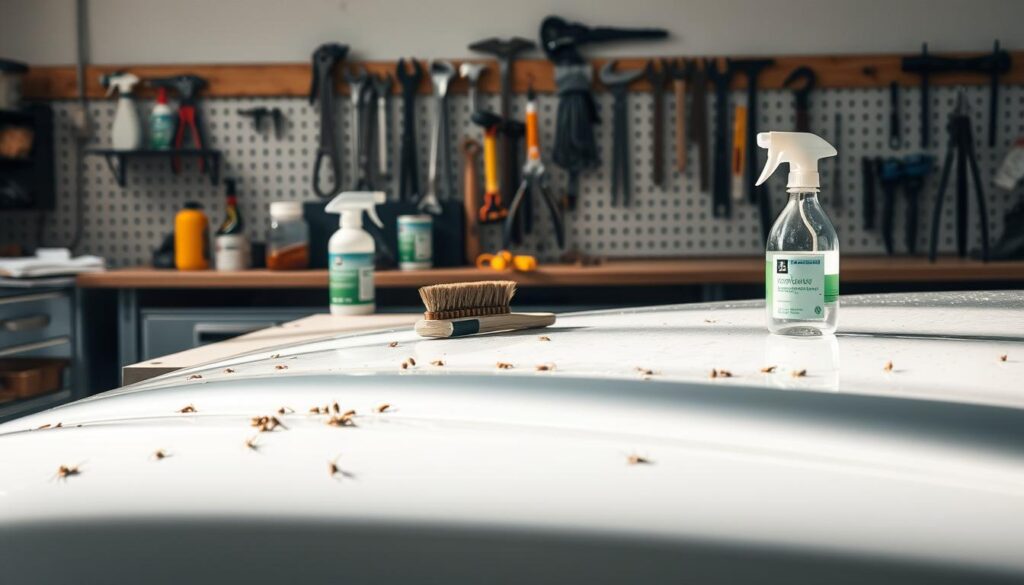
Shade, cool panels, and rinsing strategy
Choose a shady spot where the car’s surface is cool. Avoid windy places to prevent quick drying. Start by rinsing with low pressure using a 40° fan tip on an electric pressure washer with settings between 1.2–2.0 GPM and 1,500–2,000 PSI. This approach removes the dirt without harming your car’s trim or emblems.
Keep the car wet until you’re ready to apply soap. This step is crucial for removing bugs effectively from the car’s glass, paint, and plastic.
Essential tools: microfiber, foam cannon, bug sponges, and towels
Get your tools ready before wetting the car. Pick plush microfiber wash mitts with a 350–500 GSM for the paint and tight-weave towels for the windows. Use polymer honeycomb bug pads for a gentle scrub and soft detailing brushes for grilles and badges.
An MTM Hydro, Chemical Guys, or Griot’s Garage foam cannon will give a good pre-soak. Have a twist-loop drying towel with 600–1,000 GSM ready for drying. Use the two-bucket method with grit guards and a pump sprayer for spot pre-soaking. These steps help prevent swirl marks when cleaning your car.
Water quality considerations: hard water spotting prevention
Water with more than 120 ppm CaCO3 can leave spots as it dries. Using a deionized rinse system can reduce minerals; softened water or a rinse aid are good alternatives. Without DI, dry the car quickly after the last rinse.
Avoid working on hot surfaces or in direct sunlight. Pairing these methods with careful drying helps prevent spots and damage while removing bugs from your car.
best way to remove bugs from car
To clean your car without harming the paint, start with chemical solutions before physical scrubbing. This method protects the car’s shine while efficiently getting rid of bug remains. It also makes it easier to clean your car again in the future.
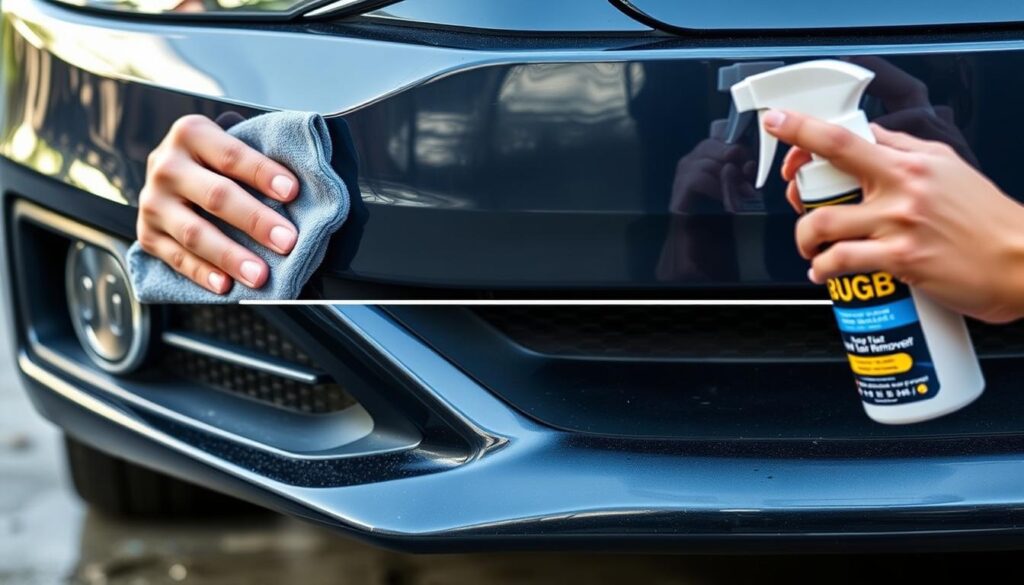
Soften first: pre-soak and dwell time fundamentals
Always work in the shade and make sure the car’s surface is cool. Use a foam pre-wash or a special bug remover from brands like Meguiar’s or Griot’s Garage. Let it sit for 3–7 minutes to soften the bug remains.
If any areas start to dry, spray them again to keep the solution active. For tough spots, hold a wet microfiber cloth on them for 30–60 seconds. This makes it easier to clean off the bugs without damage.
Lift, don’t scrub: minimizing micro-marring
When wiping, use a soft microfiber mitt and gentle pressure. Move in straight lines to pick up the bugs. Remember to switch to a clean part of the mitt frequently to avoid scratching the car.
Don’t scrub in circles. Use smooth, gentle strokes along with a premium wash soap to protect the car’s clear coat.
Rinse, inspect, and repeat with patience
After rinsing, check the car under soft light. If you see any bug marks left, go through the pre-soak process again instead of scrubbing harder. This careful approach helps keep the car looking shiny and clear.
Doing this on a car with protective paint makes it easier to clean next time, increasing the chance of getting it fully clean without any damage.
Finish with protection to reduce future adhesion
Finish up by applying a protective sealant like Turtle Wax Hybrid Solutions or CarPro Reload. This makes it harder for bugs to stick to the car later.
Adding this protection helps make future cleaning quicker and maintains the car’s appearance, especially after driving on highways.
Choosing Bug Removal Products for Cars: Sprays, Gels, and Soaps
When picking products for quick cleanup that won’t harm your car, think about the product type. Sprays, gels, and soaps work differently. They’re good for covering different areas, sticking to surfaces, and how much they cost. Knowing this can help you choose the best product to get bugs off your car.
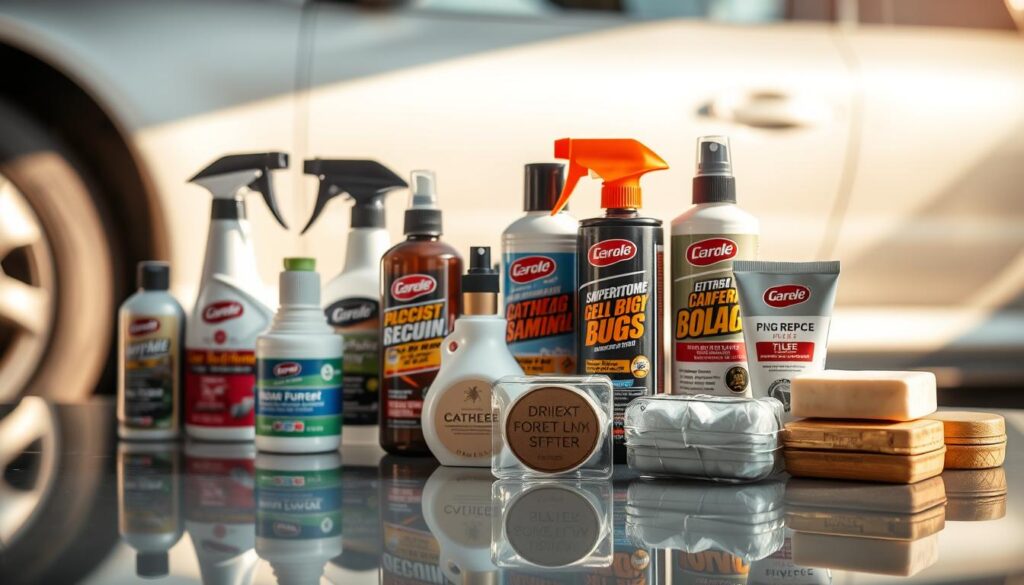
| Format | Best Use | Key Advantage | Typical Dwell | Examples (Brand/Model) |
|---|---|---|---|---|
| Spray | Large front ends, grilles, mirrors | Fast coverage; easy rinse | 2–4 minutes | Koch-Chemie Insect & Dirt Remover; Turtle Wax Bug & Tar Remover |
| Gel | Vertical panels, stubborn spots | Clings to increase contact time | 3–5 minutes | Griot’s Garage Bug & Smudge Remover (gel-type feel); Autoglym Active Insect Remover |
| Soap/Foam | Pre-soak via foam cannon | Even blanket; paint-safe | 3–6 minutes | Griot’s Garage Foaming Surface Wash; Meguiar’s Gold Class Car Wash |
pH-neutral vs. alkaline cleaners: when to use which
If your car is waxed or coated, pH-neutral products are gentle. Products like Griot’s Garage Foaming Surface Wash or Meguiar’s Gold Class are safe. They might take longer to work but won’t harm the paint. Alkaline cleaners break down bug bits faster but should be used with care, especially when it’s hot.
Know the type of dirt on your car to pick the right cleaner. Light dirt works well with neutral cleaners. Tougher grime needs an alkaline cleaner but be careful with it.
Dedicated car bug remover vs. all-purpose cleaners
Special bug removers are made to safely get bugs off cars. They don’t harm the clear coat like all-purpose cleaners might. They’re made to target bugs without removing wax or protection too quickly.
All-purpose cleaners are okay for tires or bumpers if you dilute them. But use a bug remover made for cars on painted surfaces. This helps keep your car looking good without damaging the wax.
Enzyme-based options for stubborn bug splatter removal
Enzyme cleaners, like Autoglym Active Insect Remover, break down bug bits gently. They don’t work as fast but are kinder to your car. This is good during bug season when you’re cleaning a lot.
Using an enzyme cleaner can keep your car shiny without harsh chemicals. It’s a good choice if you’re cleaning off bugs every week.
Eco-friendly and paint-safe formulas
Choosing products that are safe for the environment and your car is wise. Look for ones that say they are biodegradable and safe for car finishes. Avoid tar removers with a lot of petroleum, especially on new paint or soft plastic parts.
When looking at bug removers, gels that stick to your car save water. Foam soaps cover a lot but are gentle. Always try a small spot first and follow the instructions closely.
Step-by-Step Method for Removing Bugs from Car Paint
This method focuses on using chemistry before touch to keep your car’s front looking good. It aims to remove bugs from your car’s paint quickly while protecting the clear coat. It’s perfect for everyday cars and those used for long trips.
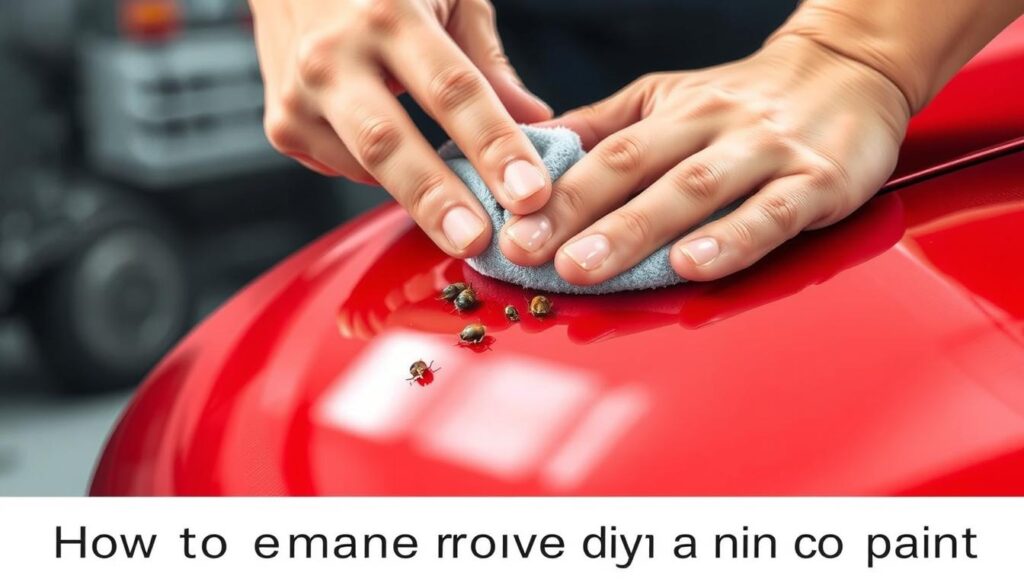
Foam pre-wash and dwell time
Fill a foam cannon with soap that’s either pH-neutral or slightly alkaline, using 1–3 ounces for every 32 ounces of water. Start at the bottom and move upwards to cover the whole area and see where the foam lands.
Let the foam stay on for 3–7 minutes in the shade, keeping the surface moist to avoid drying. This process makes it easier to remove bugs from your car without needing to scrub hard.
Targeted application of bug remover products
Use a specialized cleaner on areas that get hit the most: the front bumper, grille, mirrors, windshield, and A-pillars. Use products from trusted brands like Meguiar’s, Griot’s Garage, and Turtle Wax that are safe for car paint.
Give it 2–4 minutes to work. For glass, you might wait a bit longer and use a plastic razor gently for stubborn spots. This approach minimizes the need for scrubbing by breaking down the bug remains first.
Safe contact wash techniques with microfiber mitts
Grab a microfiber mitt, make sure it’s full of a slippery wash solution, and wash using straight, gentle strokes. Clean the mitt in a different bucket with a grit guard every time you make a pass.
When the bugs have softened, use a polymer bug sponge if necessary. Stay away from harsh pads to protect your paint. This method is best for bug removal without damaging your car’s finish.
Final rinse, drying, and inspection under good lighting
Do a final rinse with deionized water to avoid water spots. Use a filtered blower to dry crevices and emblems, then finish off with twist-loop towels for a gentle dry that protects your car’s wax and coatings.
Check your work under white LED lights that are between 4,000 and 5,000K. If you see any left-over specks, treat them again. This ensures your car is free of bugs without harming the paint.
Gentle Tools That Work: Towels, Mitts, and Bug-Specific Media
To keep your car’s paint clean and scratch-free, choose the right cleaning tool. Start with a chemistry-first method to soften insect remains. Then, gently remove them for the best chance at a flawless finish.
Microfiber grades and GSM choices for bug cleaning tips for car
Pick plush microfiber towels with 350–500 GSM for the paint. Their deep pile helps trap debris, protecting your car’s finish. This makes it easier to safely remove bugs once they’re softened.
For cleaning glass, go for microfiber towels with a tighter weave or waffle texture, ranging from 300–350 GSM. They’re great at eliminating lint and streaks, giving you clear, sharp windows. Always use separate towels for bugs to prevent spreading dirt.
Polymer bug sponges vs. aggressive pads
Use polymer honeycomb bug sponges for a gentle yet effective clean. They work best with pH-neutral shampoos from Meguiar’s, Griot’s Garage, and Koch-Chemie.
Stay away from melamine sponges and harsh pads on your car’s paint. They can damage the finish quickly. Instead, use gentle cleaning tools and apply light pressure for the best results.
Using plastic razors and detailing sticks safely on glass
Plastic razors can safely remove tough residue from glass, but only if used correctly. Use them at a low angle with plenty of soapy water. Remember to keep your strokes short and wet the surface frequently.
Microfiber-wrapped detailing sticks are perfect for tough spots like grilles and around license plates. Change the microfiber wrap often to avoid spreading dirt. This approach ensures a thorough and safe cleaning.
Protect and Prevent: Sealants, Waxes, and Coatings to Limit Future Build-Up
Want to make cleaning your car easier? Apply surface protection. It makes the car’s surface less sticky, so dirt and bugs wash off with less effort. This is the smart way to keep your car’s panels clear of bug marks.
Why protection reduces adhesion of insect residue
New protection layers make your car super slick. This means water and bug bits don’t stick as easily. So, when it’s time to clean, the job is quicker and less of a hassle.
It’s a good idea to use special bug cleaning products after driving. They help keep your car shiny and free from foggy patches.
Spray sealants vs. traditional waxes vs. ceramic coatings
Spray sealants are fast to apply and repel water well. Brands like Turtle Wax Hybrid Solutions and Griot’s Garage Ceramic 3-in-1 last 2–4 months. They stand up well to all kinds of weather.
Classic waxes, either carnauba or synthetic, add a beautiful shine. But, they need reapplying every 4–8 weeks, especially if you drive a lot. Ceramic coatings, from brands like CarPro CQuartz UK 3.0 and Gtechniq Crystal Serum Light, keep your car protected for 1–3 years if you take care of them.
Even with these coatings, removing bugs promptly is key. A protected car is easier to wash gently, keeping bug splatter from sticking too hard.
Maintenance toppers after every wash
Silica sprays after washing add extra slickness. This helps keep the car easy to clean and maintains its defenses against bugs.
In bug-heavy seasons, use spray sealants every month. Combine with bug cleaning products to keep your car looking great.
Front-end protection: PPF and grille screens
If you drive a lot, consider paint protection film from XPEL or 3M. It goes on parts of your car like bumpers and mirrors, adding extra defense. This film can fix itself from light scratches and resist marks better than just paint.
Adding a mesh screen to your grille is another smart move. It blocks bugs from hitting your car directly, making cleaning easier.
| Protection Type | Representative Brands/Models | Core Chemistry | Durability (Typical) | Application Time | Key Benefit for Bug Control | Maintenance Pairing |
|---|---|---|---|---|---|---|
| Spray Sealant | Turtle Wax Hybrid Solutions; Griot’s Garage Ceramic 3-in-1 | SiO2/Si polymer | 2–4 months | 10–20 minutes | High slickness reduces bonding | Silica detail spray after wash |
| Traditional Wax | Meguiar’s Ultimate Wax; Mothers California Gold | Carnauba/synthetic blend | 4–8 weeks | 20–40 minutes | Warm gloss with basic release | Quick wax topper biweekly |
| Ceramic Coating | CarPro CQuartz UK 3.0; Gtechniq Crystal Serum Light | SiO2/SiC | 1–3 years | 1–3 hours | Strong chemical resistance to splatter | SiO2 spray every 4–6 weeks |
| PPF (Front-End) | XPEL Ultimate Plus; 3M Scotchgard Pro | Urethane film | 5–10 years | Professional install | Thick barrier; self-heals light marks | Sealant on film for added slickness |
| Grille Screen | Removable mesh screens | Poly/metal mesh | Trip duration | 5–10 minutes | Sacrificial catch layer | Rinse and reinstall as needed |
Tip: For best results, mix various protection layers and keep up with cleaning. Using bug removal products on a slick surface is easier. This preserves the shine and clarity of your car.
Regional and Seasonal Strategies for Car Detailing Bug Removal
Want cleaner road trips and quick fuel stops? Plan for insects by region and season. A light pre-soak and a soft wipe can keep your car clean on the go.
Tip: Driving at night near water increases bug hits. Slow down a bit and keep distance from big vehicles to reduce bug splatters.
Road-trip readiness during lovebug and mayfly seasons
In late spring and summer, lovebugs swarm the Gulf Coast and Florida. Bring a pH-neutral spray, a pump sprayer, and damp towels in a zip bag. This helps quickly and safely remove bugs.
Mayflies cover cars near Midwest and Great Lakes waterways. Use grille screens and rinse at self-serve stations. These steps keep your car clean after driving.
Highway protocols: quick-clean kits for fuel stops
At stops, spray the front of your car in the shade. Wait 1–2 minutes, then wipe with a microfiber towel. This method makes cleaning bug splats off your car easier.
- Carry: collapsible bucket, low-pH glass cleaner, trash bag for used towels.
- Avoid scrubbing; let chemistry do the work before a light pass.
- Finish with a gentle rinse when a bay is available to reset the surface.
Cold-weather considerations and deicer residues
In winter, roads are salted, but this can damage your car. Rinse and dry your car’s underbody and front end quickly to prevent damage.
Don’t use hot water on cold glass to prevent cracks. Keep a protective layer on your car so bug removal stays easy in the next warm season.
| Region/Season | Primary Risk | Recommended Kit Item | Cleaner Type | Fuel-Stop Routine (Dwell) | Benefit |
|---|---|---|---|---|---|
| Gulf Coast & Florida (Apr–May, Aug–Sep) | Lovebug swarms | Small pump sprayer + damp microfiber | pH-neutral pre-soak | Mist panels; 1–2 min; gentle wipe | Faster how to clean bugs off car with less marring |
| Midwest & Great Lakes (Late Spring–Summer) | Mayfly hatches near water | Temporary grille screen | Bug-safe gel for vertical surfaces | Target grille; 2 min; blot, not scrub | Cleaner airflow and easier bug splatter removal |
| Interstates Nationwide (Year-Round Nights) | High-speed impacts near lakes/rivers | Collapsible bucket + trash bag | Low-pH glass cleaner for windshield | Spray glass; 1 min; towel flip often | Clear vision and faster car detailing bug removal |
| Northern States (Winter) | Deicer residues on bug remains | Rinse nozzle for underbody | Mild alkaline wash for salts | Rinse promptly; dry chrome and aluminum | Less staining and safer finish preservation |
Troubleshooting Stubborn Spots and Safe Escalation
If stubborn splatter doesn’t come off with a normal wash, slow down. Try re-soaking it with a gel bug remover. This keeps it wet without drying quickly. Then, cover the area with plastic wrap for 5–10 minutes, but only on cool surfaces. This trick aims to lock in moisture, helping to get rid of bug remnants with less risk of scrubbing damage.
When cleaning glass, it’s better to increase slipperiness and gently use a plastic razor, keeping it almost flat. On painted surfaces, touch them after washing. If they feel slick but look stained, you’re likely dealing with etching. Applying a mild polish like Meguiar’s M205 or Sonax Perfect Finish, using a soft foam pad at a gentle speed, can smooth things out without taking off too much. It’s wise to check the paint’s thickness beforehand to avoid making it too thin with many polishes.
If the blemish feels more stuck on than sunk in, opt for a soft clay mitt or bar. Make sure you have plenty of slick substance for sliding easily, and only treat the problem spot. If you notice any blurring, stop immediately. Then, look again at the lighting, how slippery it is, and how hard you’re pressing. This careful method is key for safely getting rid of bugs on your car’s surface without causing more issues.
Avoid strong chemicals and rough scrubbers on delicate clear coats. If there’s Paint Protection Film (PPF) on the car, use gentle cleaners from known brands like 3M, XPEL, or SunTek. A bit of warmth might fix shallow scratches; but deeply marked film might need replacing. When you’re unsure, getting a pro’s advice can save your car’s paint, helping remove bugs with little need for touch-ups.
Have realistic hopes; deep marks may require machine work, but surface transfers can often be cleared up with specific chemicals. Taking your time, using the right tools, and following these steps, makes removing bug splatter safer, more reliable, and ensures your car’s paint isn’t overworked.
Conclusion
Removing bugs from your car starts with using the right chemistry, not force. Soak for a few minutes, then use a soft microfiber to lift off the bugs. Rinse and repeat as needed. This method protects your car’s finish and makes cleaning easier later on.
When choosing bug removal products, focus on their pH. For daily washing, pH-neutral soap is best. For tougher bug spots, use mild alkaline or enzyme-based cleaners that are safe for paint. Combine them with special sponges for sticky areas. Using the right water helps avoid spots. Adding spray sealants or ceramic coatings helps protect your car even more. High-speed drivers might consider paint protection film.
The time of year and your location affect bug cleaning strategies. Keep a cleaning kit handy for quick stops. If you’re dealing with lovebugs or mayflies, clean them off quickly to avoid damage. If you still see marks, polish lightly but only if necessary. This keeps your car looking shiny, cuts down on costs, and makes cleaning bugs from glass, bumpers, and mirrors easier over time.
Overall, using the right amount of soaking time, gentle cleaning tools, and effective products is key. Choosing the best bug removal products and gentle methods makes cleaning car paint from bugs safer, faster, and more effective.

